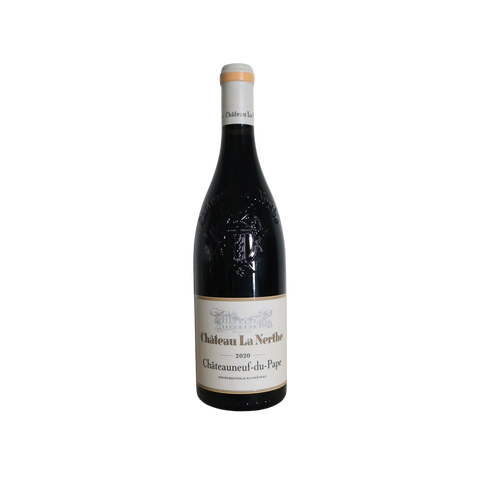
2021 Château la Nerthe Châteauneuf du Pape Rouge, Rhône Valley, France
The dark, deep, inky color of the wine shows immediately, stemming from the concentration of the vintage. Nose of blackcurrants, black tea and dried flowers stands out. The mouth is rich, fruity and velvety with an incredibly layered tannic structure. The wine is balanced and pure with strong intense and incredibly long aging potential.
There are 3 units left in stock.
ABOUT THIS WINE
Château La Nerthe, Châteauneuf-du-Pape red, is the soul of the estate’s wines. It has been exported across the globe since the eighteenth century. All the plots of Grenache Noir, Syrah, Mourvèdre, and Cinsault grapes are planted across the different soil types within the wine appellation, making the style of this wine the full expression of the complexity of Châteauneuf-du-Pape. It pairs wonderfully with rare meat, Provencal classics, or other elaborate dishes made with sauce. This Château La Nerthe is harmonious and balanced: pretty red garnet color with purplish hints. On the nose, a mix of ripe red fruits (cherry) and vegetal scents (licorice, anise). Silky textured, the wine is round, pulpy, with noticeable but supple tannins offering red stone fruits (plum) and herbal notes (menthol) on the finish. The whole confirms a solar vintage but without excess of alcohol or dryness, the wine reveals on the contrary balance with a nice freshness to watch for a decade or more.
ABOUT THIS PRODUCER
The first deed attesting to the existence of Château La Nerthe was signed on November 25, 1590, with its acquisition by the Tulle de Villefranche family. It was then a country house known as the Grange de Beauvenir. Over the next three centuries, the Tulle de Villefranche never stopped developing and beautifying their estate. Marquis Jean-Dominique Tulle de Villefranche (1711-1760) completed making it one of the flagship estates of the Rhône Valley by launching the castle's construction on the foundations of the medieval cellar. They innovated in the vineyard and the wine cellar, for example, shipping bottled wines starting in 1776, a first for the region. The Tulle de Villefranche were also tireless travelers and ambassadors for their wines, ensuring early on that they would adorn the best tables in France, Europe, and even in North America from 1786! A tradition that we are proud to continue three centuries later.
In May 1877, the Tulle de Villefranche family sold the estate, ravaged by phylloxera, to Commander Joseph Ducos. A Polytechnician like his father, Ducos, was the first to understand the interest of grafting vines on rootstock, resistant to the devastating insect, and put the work of the Montpellier School of agricultural into practice.
From Château la Nerthe: "As early as 1878, Commander Ducos undertook with tireless ardor the resurrection of his Clos de La Nerthe. He was so successful that after a few years, the winegrowers of Châteauneuf, at first incredulous and skeptical but then convinced and conquered, followed his example and imitated him. So, we can say without exaggeration that Châteauneuf owes its wine restoration to Ducos: he was the soul and the craftsman. His first concern had been to preserve the ancient qualities of La Nerthe wines, their body, and bouquet. For that, he had tried to graft only the territory's old plants, Mourvèdre, Grenache, Terret, Syrah, Counoise, red grape varieties, giving heat, liquor, mellowness, solidity; and then Clairette and Picpoul, white grape varieties intended to bring finesse, freshness and a distinct bouquet."
Today, the Richard Family envisions the wines of tomorrow and continues to write the story of Château La Nerthe, with the ambition of preserving and revealing this unique architectural and wine-making heritage. After a troubled period, marked by the requisition of the castle by the German occupation army in 1943, the Richard Family acquired the estate in April 1985. They immediately displayed the ambition to go back to the original values of excellence and innovation of the two illustrious families that preceded them. They undertook the meticulous restoration of the castle and the digging of a modern wine cellar.
Above all, they focused efforts on the vineyard, extending it in 1991, from 60 to 92 hectares (148-227 acres) with the acquisition of magnificent plots located in neighboring La Crau. These additional parcels included an extraordinary heritage of old vines, some dating back to the end of the 19th century.
At the same time, the entire estate was converted to organic farming, obtaining Ecocert certification in 1998. Château La Nerthe, once again a pioneer!
